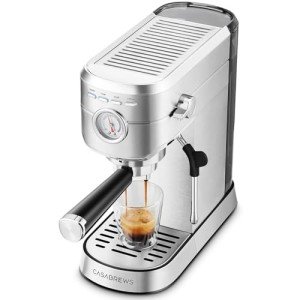The Ultimate Guide to Cappuccino Machines: Brewing the Perfect Cup
Coffees are a cherished coffee drink that integrates the abundant tastes of espresso with steamed milk and milk foam. For White Espresso Machines , absolutely nothing tastes much better than a homemade cappuccino crafted with accuracy. Nevertheless, duplicating the ability of a barista in the house requires the right equipment. This is where cappuccino machines enter into play. This short article digs into the various kinds of cappuccino machines, how they work, and suggestions for selecting the very best one for your needs.
What is a Cappuccino Machine?
A cappuccino machine is a specialized developing device developed to make cappuccinos and other espresso-based drinks. These machines usually include a built-in espresso maker, a milk frother, and different controls for adjusting temperature and pressure. Cappuccino machines can be manual, semi-automatic, or totally automatic, offering different levels of user control depending upon the complexity of the machine.
Types of Cappuccino Machines
1. Manual Espresso Machines
- Description: These machines need users to run most functions by hand, consisting of grinding coffee beans, tamping the grounds, pulling the espresso shot, and frothing the milk.
- Pros:
- Offers total control over the developing process.
- Can produce high-quality, café-like espresso.
- Cons:
- Steeper learning curve.
- Requires more effort and time.
2. Semi-Automatic Espresso Machines
- Description: Semi-automatic machines automate some processes, such as water pressure. Users still need to grind coffee and froth milk by hand.
- Pros:
- Balanced control and benefit.
- Enables room for experimentation.
- Cons:
- Still needs practical abilities.
- Can be intricate for beginners.
3. Completely Automatic Espresso Machines
- Description: These machines automate the whole brewing process, from grinding to frothing. Italian Espresso Machines choose the desired beverage.
- Pros:
- Extremely convenient and easy to use.
- Constant results with little effort.
- Cons:
- More costly.
- Minimal control over the developing procedure.
4. Super Automatic Espresso Machines
- Description: Similar to completely automatic machines, but these designs include features like an integrated milk frother and grinder. They prepare drinks with simply the touch of a button.
- Pros:
- Ultimate benefit; makes different drinks quickly.
- Integrated cleaning and upkeep features.
- Cons:
- High preliminary expense.
- Less hands-on experience with coffee making.
Secret Features to Consider
When choosing a cappuccino machine, a number of features can significantly affect efficiency and user experience. Here are some vital aspects to assess:
1. Construct Quality
- Products utilized (stainless steel, plastic)
- Durability and longevity
2. Capacity
- Water reservoir size
- Bean hopper capability
3. Frothing Capability
- Type of frothing wand (manual, automatic)
- Steam pressure and temperature level control
4. Ease of Use
- Intuitive controls
- Cleaning up and maintenance requirements
5. Rate
- Range from budget to high-end models
- Consider guarantees and consumer assistance alternatives
6. Brand Reputation
- User reviews and skilled viewpoints
- Availability of replacement parts
The Brewing Process
To brew the perfect cappuccino at home, follow this procedure, despite the machine type:
- Prepare the Espresso: Use freshly ground coffee beans and pull a double shot (around 2 ounces) of espresso.
- Froth the Milk: Steam fresh milk to a temperature level about 150 ° F( 65 ° C)utilizing the steam wand or automatic frother.
- Combine: Pour the steamed milk over the espresso, followed by a layer of milk foam (equivalent parts espresso and steamed milk, with about 1 cm of foam).
For a graph, here's an easy table comparing the characteristics of the cappuccino machine types:
| Machine Type | Control Level | Relieve of Use | Rate Range | Perfect For |
|---|---|---|---|---|
| Manual Espresso Machine | High | Challenging | Low to Medium | Coffee lovers, perfectionists |
| Semi-Automatic Machine | Medium | Moderate | Medium | Home baristas, enthusiasts |
| Totally Automatic Machine | Low | Easy | Medium to High | Casual drinkers |
| Super Automatic Machine | Very Low | Really Easy | High | Hectic experts |
Often Asked Questions (FAQs)
What is the best milk to use for cappuccinos?
Entire milk is typically preferred for frothing due to its fat content, which creates a creamy texture. However, alternatives like almond milk, oat milk, or soy milk can be utilized, though they may require different frothing methods.
How do I clean my cappuccino machine?
A lot of machines include specific cleansing instructions. Typically, you ought to routinely clean the group head, steam wand, and drip tray. For automatic machines, numerous models feature self-cleaning cycles.
Can I use pre-ground coffee instead of whole beans?
Yes, you can use pre-ground coffee. However, freshly ground coffee usually produces a more tasty espresso due to the oils in the beans being maintained.
How much should I invest in a cappuccino machine?
The price varies considerably based on functions, brand name, and quality. A basic, good quality machine may start around ₤ 200, while high-end super automatic machines can go beyond ₤ 2,000.
How typically should I replace my cappuccino machine?
With appropriate maintenance, a high-quality cappuccino machine can last for numerous years. Nevertheless, you might consider upgrading if you find your machine no longer fulfills your developing needs or experiences efficiency problems.
Cappuccino machines are effective allies in delivering the perfect brew at home. Whether you prefer manual interaction with your coffee or prefer the benefit of completely automated machines, understanding the different types and their functions will assist you in making the best option. By buying the ideal machine for your needs and using the right strategies, anyone can enjoy a barista-quality cappuccino from the convenience of their own kitchen area. With a little perseverance and imagination, the art of cappuccino developing can become a delightful routine, developing not simply coffee however moments of delight.

